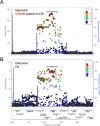A proteogenomic view of Parkinson's disease causality and heterogeneity
- PMID: 36774388
- PMCID: PMC9922273
- DOI: 10.1038/s41531-023-00461-9
A proteogenomic view of Parkinson's disease causality and heterogeneity
Abstract
The pathogenesis and clinical heterogeneity of Parkinson's disease (PD) have been evaluated from molecular, pathophysiological, and clinical perspectives. High-throughput proteomic analysis of cerebrospinal fluid (CSF) opened new opportunities for scrutinizing this heterogeneity. To date, this is the most comprehensive CSF-based proteomics profiling study in PD with 569 patients (350 idiopathic patients, 65 GBA + mutation carriers and 154 LRRK2 + mutation carriers), 534 controls, and 4135 proteins analyzed. Combining CSF aptamer-based proteomics with genetics we determined protein quantitative trait loci (pQTLs). Analyses of pQTLs together with summary statistics from the largest PD genome wide association study (GWAS) identified 68 potential causal proteins by Mendelian randomization. The top causal protein, GPNMB, was previously reported to be upregulated in the substantia nigra of PD patients. We also compared the CSF proteomes of patients and controls. Proteome differences between GBA + patients and unaffected GBA + controls suggest degeneration of dopaminergic neurons, altered dopamine metabolism and increased brain inflammation. In the LRRK2 + subcohort we found dysregulated lysosomal degradation, altered alpha-synuclein processing, and neurotransmission. Proteome differences between idiopathic patients and controls suggest increased neuroinflammation, mitochondrial dysfunction/oxidative stress, altered iron metabolism and potential neuroprotection mediated by vasoactive substances. Finally, we used proteomic data to stratify idiopathic patients into "endotypes". The identified endotypes show differences in cognitive and motor disease progression based on previously reported protein-based risk scores.Our findings not only contribute to the identification of new therapeutic targets but also to shape personalized medicine in CNS neurodegeneration.
© 2023. The Author(s).
Conflict of interest statement
The authors report no competing interests. A.S. is an editor for npj Parkinson’s Disease. A.S. was not involved in the journal’s review of, or decisions related to, this paper.
Figures



Similar articles
-
Proteome wide association studies of LRRK2 variants identify novel causal and druggable proteins for Parkinson's disease.NPJ Parkinsons Dis. 2023 Jul 8;9(1):107. doi: 10.1038/s41531-023-00555-4. NPJ Parkinsons Dis. 2023. PMID: 37422510 Free PMC article.
-
Clinical and dopamine transporter imaging characteristics of non-manifest LRRK2 and GBA mutation carriers in the Parkinson's Progression Markers Initiative (PPMI): a cross-sectional study.Lancet Neurol. 2020 Jan;19(1):71-80. doi: 10.1016/S1474-4422(19)30319-9. Epub 2019 Oct 31. Lancet Neurol. 2020. PMID: 31678032 Free PMC article.
-
Mutations in GBA and LRRK2 Are Not Associated with Increased Inflammatory Markers.J Parkinsons Dis. 2021;11(3):1285-1296. doi: 10.3233/JPD-212624. J Parkinsons Dis. 2021. PMID: 33998549 Free PMC article.
-
Precision medicine in Parkinson's disease patients with LRRK2 and GBA risk variants - Let's get even more personal.Transl Neurodegener. 2020 Oct 16;9(1):39. doi: 10.1186/s40035-020-00218-x. Transl Neurodegener. 2020. PMID: 33066808 Free PMC article. Review.
-
[GBA mutations and Parkinson's disease].Sheng Li Xue Bao. 2018 Jun 25;70(3):294-300. Sheng Li Xue Bao. 2018. PMID: 29926071 Review. Chinese.
Cited by
-
Transcriptional pathobiology and multi-omics predictors for Parkinson's disease.bioRxiv [Preprint]. 2024 Jun 21:2024.06.18.599639. doi: 10.1101/2024.06.18.599639. bioRxiv. 2024. PMID: 38948706 Free PMC article. Preprint.
-
Proteome wide association studies of LRRK2 variants identify novel causal and druggable proteins for Parkinson's disease.NPJ Parkinsons Dis. 2023 Jul 8;9(1):107. doi: 10.1038/s41531-023-00555-4. NPJ Parkinsons Dis. 2023. PMID: 37422510 Free PMC article.
-
Meta-analysis of the make-up and properties of in vitro models of the healthy and diseased blood-brain barrier.Nat Biomed Eng. 2024 Sep 20. doi: 10.1038/s41551-024-01250-2. Online ahead of print. Nat Biomed Eng. 2024. PMID: 39304761
-
GPNMB Biomarker Levels in GBA1 Carriers with Lewy Body Disorders.Mov Disord. 2024 Jun;39(6):1065-1070. doi: 10.1002/mds.29773. Epub 2024 Apr 12. Mov Disord. 2024. PMID: 38610104
-
Epigenetic regulation of Parkinson's disease risk variant GPNMB cg17274742 methylation by sex and exercise from Taiwan Biobank.Front Aging Neurosci. 2023 Sep 7;15:1235840. doi: 10.3389/fnagi.2023.1235840. eCollection 2023. Front Aging Neurosci. 2023. PMID: 37744396 Free PMC article.
References
LinkOut - more resources
Full Text Sources

